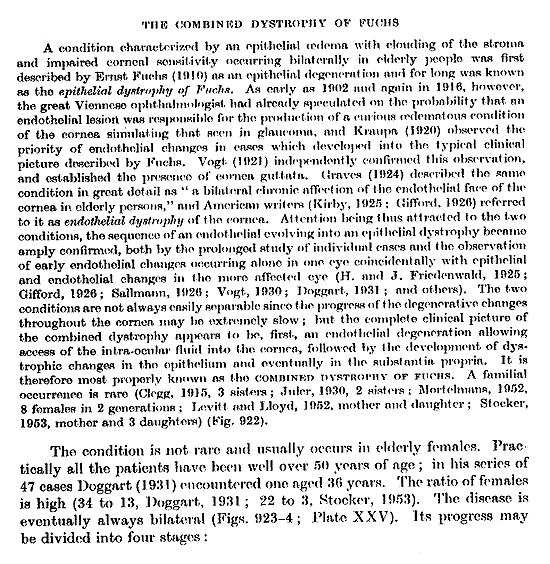These notes are in no particular order. In fact they're a kind of jumble.
They didn't make much sense to me back in the 80's, but now they do.
=====================================================
Ernst Fuchs (1910) Viennese
Epithelial Dystrophy--in younger women a rare condition preceded by endothelial dystrophy.
Hyperactive endothelial cells destroy the aqueous barrier giving edema of the
stroma & waterlogging of epithelial cells.
Dystrophy--a degenerative change
Condition is not rare in old women, but is familial if found in young women.
Occurs in 5th decade of life.
Found 3 to 1 more in families. Almost always in women.
Endothelium--most posterier part of cornea, 1 layer of cells
Epithelium--5 layers of cells, very sensitive, has nerve endings
Light sensitivity to bright sun on a light surface, such as streets, sand, water
Progress of the degeneration may be extremely slow.
Corneal transplants are 75% successful, but not always effective.
Protect eyes from ultraviolet rays--get UV400 in glasses
Fuch's dystrophy
AD, F>M, (most common in post menopausal women)
bilateral and asymmetric, rare in Orientals
central guttata first, pigment in endothelium (can have borders)
1st degree relatives 40% with guttata, incomplete penetrance
worse Va (visual acuity) in mornings, humid days, increased IOP
rarely pigmented gutatta can decrease Va (20/60 range)
in long standing cases, subepithelial fibrosis, grayish Descemet
thickening
posterior collagenous layer can obscure all the guttata
diff dx of corneal edema--other endothelial problems, PPMD, disciform
keratitis
Increased Corneal Scarring after Phototherapeutic
Keratectomy
in Fuchs=92 Corneal Dystrophy
Rx
only if symptomatic, treat as in other causes of corneal edema
if considering phacoemulsification check corneal thickness
One of the books I read was THE EYE: A Clinical and Basic Science Book by E. Howard Bedrossian, MD, published by Charles C. Thomas in Springfield, IL. Another excellent book was called Corneal Diseases. Unfortunately, I did not note the author, but it is quite clinical and has extensive references and footnotes. Among my chicken scratches in my notes is the name Duke-Elder (see notes at end of page) who may have been the author or perhaps a reference.
 |
|---|
Sir Stewart Duke-Elder, Scotland's leading ophthalmologist, 1898-1978, wrote or edited a set of 15 books, classic manual for eye surgeons, entitled "Textbook of Ophthalmology."
Summary of systemic ophthalmology
The physiology of the eye and of vision
Ophthalmic optics and refraction
Ocular motility and strabismus
The ocular adnexa
Normal and abnormal development
Neuro-ophthalmology
Injuries
The Foundations of ophthalmology: heredity,
The Eye in evolution
Diseases of the uveal tract
Diseases of the retina
Diseases of the outer eye
Diseases of the lens and vitreous: glaucoma and
The anatomy of the visual system